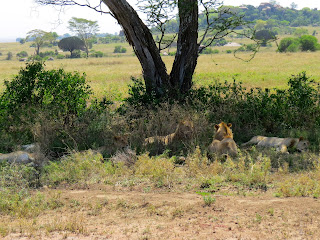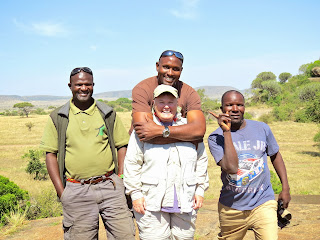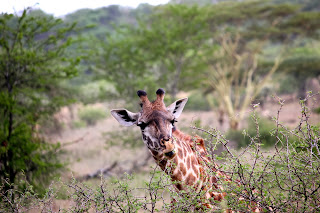Out again just at dawn.
Beside the road a pride
of lions loiter, (a dominant male with two young males and two females). A
waterbuck runs by and the lions take notice, but slowly, lazily. Two stand and
wander in the direction of the buck, (who’s long gone by now). One by one they
stand and then slowly, leisurely they cross the road in front of us. They seem
to be interested in a small herd of Cape buffalo grazing along the river. We
watch as they deploy themselves strategically in the long grass (which matches
their color exactly).
We observe, while they
maneuver, for almost an hour. Inside our jeep it’s as silent as the bush. The
cats move to improve their position, the definition of stealth in the visual
dictionary. They are attempting to surround a single buffalo with aggravating
patience. In the end, they have miscalculated. The mastermind behind the
strategy is a “bad mathematician” according to Stanley. The male lions wrestle
with one another, unconcerned. Game over, maybe next time.
 |
| Silence While We Watch |
A young (6-8 month)
jackal is as interested in us as we are in her. Approaching the jeep with a
sniff, she’s bravely curious and then off into the sun-splashed grass. Mommy
calling?
 |
| Jackal Youngster |
Our guides are hoping
to complete for us the Big Five. Today we search for the last on the list, the
elusive rhino. There are only 20 in the entire Serengeti, where they’ve been poached
into near extinction.
The Moru is dotted with
Kopjes. They interrupt the Serengeti plains. Kopje means little head. The
knobby tops are pushed up from the earth; the “body” remains embedded. They are
huge, 500 million year old rocks, piled in intricate patterns, smooth granite
boulders, stacked like irregular Jenga blocks. They make ideal hiding places
for lion cubs, and snakes. And they make great vantage points. Because they
provide good cover many animals lurk there.
 |
| Rock Garden |
 |
| Candelabra Tree |
It’s greener here.
Kopjes hold moisture. Tree trunks wedged into crevices are twisted into
asymmetrical shapes. They are rock gardens haphazardly planted by nature with
beautiful results.
A rhino was sighted in
the Moru area two days ago. Our jeeps fan out, the guides using binos and their
eagle eyed experience. They are in touch by radio. If something is spotted
we’ll all converge.
Meanwhile we sit back
and watch the wildlife. The crazy-looking Secretary bird, the Kori Bustard,
elephants, giraffe, ostrich, zebra, Defassa waterbucks, elephants; a single
baboon sitting facing the road watching the people pass by…only fair.
 |
| Mud Bath |
 |
| Defassa Waterbuck |
 |
| Secretary Bird With Pencils In Her Hair |
Two cheetahs sitting
tall in the grass with gazelles abundant around them. Cheetahs have become
customary by now but never, never ordinary.
A Cape buffalo with a tiny
red bird riding between his horns, (eating ticks), enjoying the ride and the
view.
 |
| See That Little Bird? |
An eland, the largest
antelope in Africa.
Herds of Grant’s
Gazelles and Tommy’s mingle together (we are now using the familiar name for
the Thomson Gazelle).
A pride of 9 lions in
the shade of a tree, resting. They look our way and seem to know they needn’t
bother, not a bit. They look right through us. King of the jungle, indeed.
We stop at a ranger
station hidden behind a kopje. The 150 rangers have the very dangerous job of monitoring
and protecting the black rhinos in the park. They carry AK47s, the same
firepower as the poachers.
Several techniques are
employed to keep track of the park’s rhinos. The rangers photograph their
tracks and “finger print” them. Each footprint is unique to the animal…they
have wrinkles on the soles of their feet.
Transmitters are
embedded in the rhino’s horns. The rangers know where each animal is but can’t
say, providing ultra security for the rhinos. I just want to know where ONE is,
so we can see him! No dice.
Up a short trail is a primitive display room
where a ranger leads us through the displays.
Rhinos use their horns
for greeting and mating behavior, rubbing them together up and down. The horns
continually grow.
The black rhino is a
browser, eats grass, leaves, shrubs, flowers, and fruit.
 |
| Rhino Information Room |
 |
| View From the Kopje |
 |
| Group Photo |
Ombeni offers us the
use of the happy room, a happy rock, or a happy bush, then we’re bronco bustin’
in the jeep rodeo back to camp for brunch.
When we pass through a
tsetse fly swarm I notice we’ve become quite cavalier about them. At first we
swatted chaotically, near panic. Now, we don’t even bother.
We rest in the heat of
the day, like the lions. The bottled water goes from cool to bath water.
During the late
afternoon game drive, (our last in the Serengeti), three spotted hyenas lope by
with purpose, in stiff formation. A dozen yellow beaked storks hunker down on
the river bank, a cool breeze riffling their feathers. A black faced vervet
monkey, (how does Dom know all of
this, and in 6 languages?)
We see swathes, tiers, and
layers of animals… appearing in the front row, orchestra, mezzanine, and balcony.
Dom has been counting and
tells us we have seen 68 different lions since we got here.
Fittingly, the giraffe is
Tanzania’s national animal, a gentle animal, and the symbol for a peaceful
country.
There are only 7
permanent lodges in the Serengeti. Officials have been prudent about allowing
development without first carefully studying the effects on the animals.
At end of day we climb
a set of wavy concrete steps to the top of a kopje to take a final scan of the
plains for the elusive rhino. No rhinos. Dom says, “ If they don’t want to see
us, they don’t know what they are missing.” Our guides are smart, funny and
kind.
 |
| Ombeni Coming Down the Kopje |
There’s a gong rock at
the top of the kopje. We take turns striking it with a stone and listening to
it chime.
 |
| Chime Rock |
 |
| Chiming |
When we pass our pride
of hunting lions they are still monitoring the water hole waiting for an
easy catch. Amazing persistence.
We beat another rapid
retreat to get back to camp before curfew. We’ve got the rhythm of the land
cruiser windows down pat. We slide open for air; slide closed for dust with a sand
papery glide. In unison: open, shut, open shut, open shut-shut-shut to a
musical beat.
Cold beer tonight, I
try the Serengeti. There’s a lion on the label, but it tastes like something
even a lion wouldn’t drink. I’ll stick with Tusker.
The camp kitchen turns
out remarkable food, formally served, from a tent at the rear of the
campground. A major accomplishment everything considered.
 |
| Camp Kitchen |
 |
| Our Camp Cook |
A group of elephants
raid the water supply while we’re eating dinner. They come up behind the row of
tents and siphon the water out of the tanks used for the toilets. Such smart
animals (them, not us). The camp staff beats on pans and honks truck horns to
frighten them away.
Walking back to our
tents in the dark, our tent lantern has gone out. We stop at the last lit tent
and start a chain reaction causing everyone behind us to stop at the wrong tent.
Whoops! We hoot and holler, probably startling the zebras.
Our screened windows
can be zipped closed, but why? I want to see and hear everything. It’s my last
chance to observe from my pillow through my corner office tent window. There’s
long dry grass and acacia trees in two directions.
I am but a dusty speck
in the Serengeti a transient guest in this animal-topia .
The sun sets behind the
Sopas.
The sky is bright with
stars, with an unobstructed Milky Way in the foreground, until the full moon
rises and takes over.
I fall asleep listening
to the music of the night.





































No comments:
Post a Comment